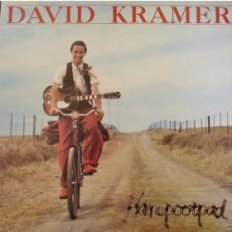
- Boggom en Voetsek
- Released in: 1981
This song by David Kramer tells the colourful narrative of two lonesome down-and-outers who travel together until they are arrested.

This song by David Kramer tells the colourful narrative of two lonesome down-and-outers who travel together until they are arrested.

This 1981 song is probably one of David Kramer's best loved boeremusiek songs. It tells the colourful narrative of two lonesome down-and-outers who travel together until they are arrested. Boeremusiek is believed to have originated from European military marching bands. Throughout the centuries, many changes came into it, such as the additions of the concertina and the bekvluitjie. A concertina is like an accordion, although there are many types of it, as illustrated by the diversity of boeremusiek; while a bekvluitjie is like a harmonica, with the "bek" referring to an animal’s mouth and the "vluitjie" to a whistle. When one listens to boeremusiek, one forgets its origins and is introduced to the heart of South African traditional music.
Regarding the title of the song, “Boggom en Voetsek,” "boggom" means baboon; and "voetsek" is a word used to tell a dog to go away, and is incredibly derogatory when used on humans, since not only is the person being told to go away but he or she is also being referred to as a "straat brak," or street mutt. Afrikaans cannot be directly translated because it is a language of metaphors and dialects unique to its geographical area. Kramer is renowned as a storyteller, and very few people are able to convey the topography, the spirit, and the culture of the Northern Cape folk as he is.
Kramer started out singing in the raw dialect of the Boland region of the Western Cape province, telling stories about tiny farm villages. He travelled from place to place with his guitar, his red vellies (from the word veldskoen, "veld" meaning field and "skoen" meaning shoe), and his black bicycle.

“Boggom en Voetsek” begins in a very quiet town in the Northern Cape province, named Karoo. Two characters drive on an old Pontiac. Boggom, “the baboon,” is behind the wheel with his "bloujannas" (blue jeans), his hat with a tiger print band, and his "frokkie" (a t-shirt) with the message “Kentucky is finger-licking good.” This is a portrayal of the typical Boer in South Africa. Voetsek, “the dog,” is in the backseat.
Kramer emphasizes how Boggom is in control and at ease, while Voetsek is “sluk aan ‘n kannetjie wyn.” "Sluk" refers to an animal swallowing, and it’s derogatory when it describes a human, as in this case: Voetsek is excitedly slukking a box of wine. A common idiom is used next, “gee nou vet.” It literally translates into “now give fat,” and it means adding fat to a fire, speeding up, accelerating, expediting. Voetsek is enticing his ou pêl (old friend) to drive faster, until the odometer meter can no longer be seen.

The chorus depicts the vivid landscape of the Northern Cape, using the expression "knersveldvlakte." "Kners" is a verb which means to gnash, as in the gnashing or grinding of teeth; "veld" is a field; and "vlaktes" refers to a flat, dry plain. One can almost feel the hardship and strife of the terrain. The dust is termed "stoffie," a diminutive form of stof or dust. Afrikaners often use the diminutive form to add a sense of endearment or fondness to the subject at hand.
Voetsek is the only character in the story to receive a proper surname, Van der Merwe. It suggests a stereotypical Boer right-wing Afrikaner, and in conjunction with the name Voetsek, it adds a whole new dimension to the song. Boggom and Voetsek are eventually caught, and the song concludes by mentioning how, after their release, Boggom became a member of the city council and Voetsek died.